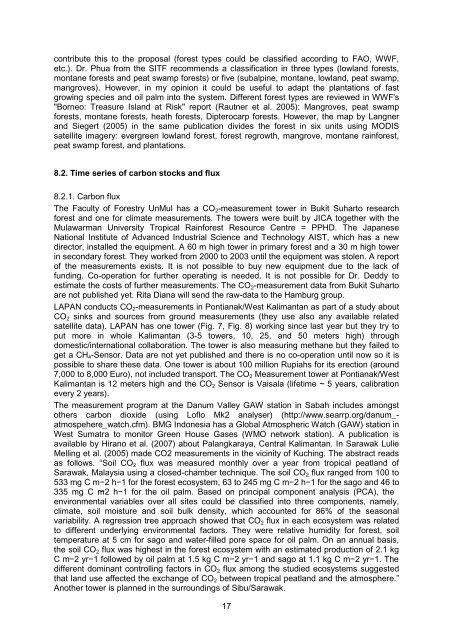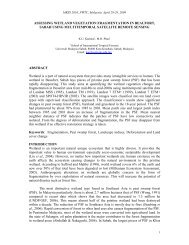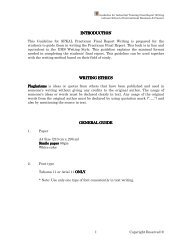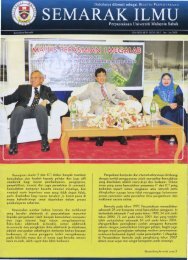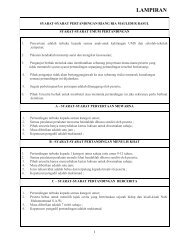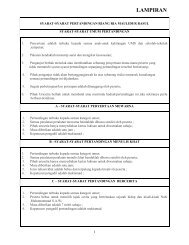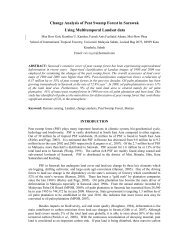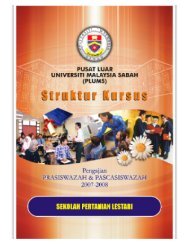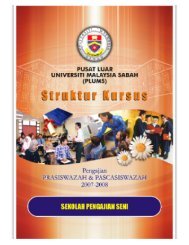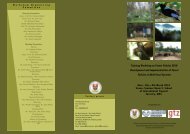Report for the German Agency for Technical Cooperation (GTZ) - UMS
Report for the German Agency for Technical Cooperation (GTZ) - UMS
Report for the German Agency for Technical Cooperation (GTZ) - UMS
Create successful ePaper yourself
Turn your PDF publications into a flip-book with our unique Google optimized e-Paper software.
contribute this to <strong>the</strong> proposal (<strong>for</strong>est types could be classified according to FAO, WWF,<br />
etc.). Dr. Phua from <strong>the</strong> SITF recommends a classification in three types (lowland <strong>for</strong>ests,<br />
montane <strong>for</strong>ests and peat swamp <strong>for</strong>ests) or five (subalpine, montane, lowland, peat swamp,<br />
mangroves). However, in my opinion it could be useful to adapt <strong>the</strong> plantations of fast<br />
growing species and oil palm into <strong>the</strong> system. Different <strong>for</strong>est types are reviewed in WWF's<br />
"Borneo: Treasure Island at Risk" report (Rautner et al. 2005): Mangroves, peat swamp<br />
<strong>for</strong>ests, montane <strong>for</strong>ests, heath <strong>for</strong>ests, Dipterocarp <strong>for</strong>ests. However, <strong>the</strong> map by Langner<br />
and Siegert (2005) in <strong>the</strong> same publication divides <strong>the</strong> <strong>for</strong>est in six units using MODIS<br />
satellite imagery: evergreen lowland <strong>for</strong>est, <strong>for</strong>est regrowth, mangrove, montane rain<strong>for</strong>est,<br />
peat swamp <strong>for</strong>est, and plantations.<br />
8.2. Time series of carbon stocks and flux<br />
8.2.1. Carbon flux<br />
The Faculty of Forestry UnMul has a CO2-measurement tower in Bukit Suharto research<br />
<strong>for</strong>est and one <strong>for</strong> climate measurements. The towers were built by JICA toge<strong>the</strong>r with <strong>the</strong><br />
Mulawarman University Tropical Rain<strong>for</strong>est Resource Centre = PPHD. The Japanese<br />
National Institute of Advanced Industrial Science and Technology AIST, which has a new<br />
director, installed <strong>the</strong> equipment. A 60 m high tower in primary <strong>for</strong>est and a 30 m high tower<br />
in secondary <strong>for</strong>est. They worked from 2000 to 2003 until <strong>the</strong> equipment was stolen. A report<br />
of <strong>the</strong> measurements exists. It is not possible to buy new equipment due to <strong>the</strong> lack of<br />
funding. Co-operation <strong>for</strong> fur<strong>the</strong>r operating is needed. It is not possible <strong>for</strong> Dr. Deddy to<br />
estimate <strong>the</strong> costs of fur<strong>the</strong>r measurements. The CO2-measurement data from Bukit Suharto<br />
are not published yet. Rita Diana will send <strong>the</strong> raw-data to <strong>the</strong> Hamburg group.<br />
LAPAN conducts CO2-measurements in Pontianak/West Kalimantan as part of a study about<br />
CO2 sinks and sources from ground measurements (<strong>the</strong>y use also any available related<br />
satellite data). LAPAN has one tower (Fig. 7, Fig. 8) working since last year but <strong>the</strong>y try to<br />
put more in whole Kalimantan (3-5 towers, 10, 25, and 50 meters high) through<br />
domestic/international collaboration. The tower is also measuring methane but <strong>the</strong>y failed to<br />
get a CH4-Sensor. Data are not yet published and <strong>the</strong>re is no co-operation until now so it is<br />
possible to share <strong>the</strong>se data. One tower is about 100 million Rupiahs <strong>for</strong> its erection (around<br />
7,000 to 8,000 Euro), not included transport. The CO2 Measurement tower at Pontianak/West<br />
Kalimantan is 12 meters high and <strong>the</strong> CO2 Sensor is Vaisala (lifetime ~ 5 years, calibration<br />
every 2 years).<br />
The measurement program at <strong>the</strong> Danum Valley GAW station in Sabah includes amongst<br />
o<strong>the</strong>rs carbon dioxide (using Loflo Mk2 analyser) (http://www.searrp.org/danum_atmospehere_watch.cfm).<br />
BMG Indonesia has a Global Atmospheric Watch (GAW) station in<br />
West Sumatra to monitor Green House Gases (WMO network station). A publication is<br />
available by Hirano et al. (2007) about Palangkaraya, Central Kalimantan. In Sarawak Lulie<br />
Melling et al. (2005) made CO2 measurements in <strong>the</strong> vicinity of Kuching. The abstract reads<br />
as follows. “Soil CO2 flux was measured monthly over a year from tropical peatland of<br />
Sarawak, Malaysia using a closed-chamber technique. The soil CO2 flux ranged from 100 to<br />
533 mg C m−2 h−1 <strong>for</strong> <strong>the</strong> <strong>for</strong>est ecosystem, 63 to 245 mg C m−2 h−1 <strong>for</strong> <strong>the</strong> sago and 46 to<br />
335 mg C m−2 h−1 <strong>for</strong> <strong>the</strong> oil palm. Based on principal component analysis (PCA), <strong>the</strong><br />
environmental variables over all sites could be classified into three components, namely,<br />
climate, soil moisture and soil bulk density, which accounted <strong>for</strong> 86% of <strong>the</strong> seasonal<br />
variability. A regression tree approach showed that CO2 flux in each ecosystem was related<br />
to different underlying environmental factors. They were relative humidity <strong>for</strong> <strong>for</strong>est, soil<br />
temperature at 5 cm <strong>for</strong> sago and water-filled pore space <strong>for</strong> oil palm. On an annual basis,<br />
<strong>the</strong> soil CO2 flux was highest in <strong>the</strong> <strong>for</strong>est ecosystem with an estimated production of 2.1 kg<br />
C m−2 yr−1 followed by oil palm at 1.5 kg C m−2 yr−1 and sago at 1.1 kg C m−2 yr−1. The<br />
different dominant controlling factors in CO2 flux among <strong>the</strong> studied ecosystems suggested<br />
that land use affected <strong>the</strong> exchange of CO2 between tropical peatland and <strong>the</strong> atmosphere.”<br />
Ano<strong>the</strong>r tower is planned in <strong>the</strong> surroundings of Sibu/Sarawak.<br />
17


